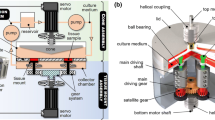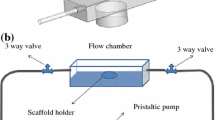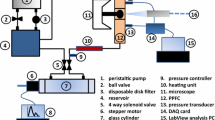Abstract
In vitro arterial flow bioreactor systems are widely used in tissue engineering to investigate response of endothelial cells to shear. However, the assumption that such models reproduce physiological flow has not been experimentally tested. Furthermore, shear stresses experienced by the endothelium are generally calculated using a Poiseuille flow assumption. Understanding the performance of flow bioreactor systems is of great importance, since interpretation of biological responses hinges on the fidelity of such systems and the validity of underlying assumptions. Here we test the physiologic reliability of arterial flow bioreactors and the validity of the Poiseuille assumption for a typical system used in tissue engineering. A particle image velocimetry system was employed to experimentally measure the flow within the vessel with high spatial and temporal resolution. Two types of vessels were considered: first, fluorinated ethylene propylene (FEP) tubing representative of a human artery without cells; and second, FEP tubing with a confluent layer of endothelial cells on the vessel lumen. Instantaneous wall shear stress (WSS), time-averaged WSS, and oscillatory shear index were computed from velocity field measurements and compared between cases. The flow patterns and resulting wall shear were quantitatively determined to not accurately reproduce physiological flow, and that the Poiseuille flow assumption was found to be invalid. This work concludes that analysis of cell response to hemodynamic parameters using such bioreactors should be accompanied by corresponding flow measurements for accurate quantification of fluid stresses.








Similar content being viewed by others
Abbreviations
- E :
-
Tensile modulus
- C :
-
Compliance
- Re :
-
Reynolds number
- α :
-
Womersley number
- u avg :
-
Average flow velocity
- D :
-
Vessel diameter
- ν :
-
Kinematic viscosity
- ω :
-
Pulse frequency
- n :
-
Index of refraction
- μ :
-
Dynamic viscosity
- τ w(x,t):
-
Instantaneous wall shear stress
- \( \overline{{\tau_{\text{w}} }} \left( x \right) \) :
-
Time-averaged wall shear stress
- ε:
-
Measurement uncertainty
- OSI:
-
Oscillatory shear index
- N t :
-
Number of time points
- T :
-
Cycle period
- P :
-
Pressure
- Q :
-
Volumetric flow rate
- t i :
-
Cycle interval
- x*:
-
Nondimensionalized axial position
- y*:
-
Nondimensionalized radial position
- R c :
-
Reverse coefficient
- L e :
-
Entrance length
- PIV:
-
Particle image velocimetry
- HMEC:
-
Human microvascular endothelial cells
- FEP:
-
Fluorinated ethylene propylene
- WSS:
-
Wall shear stress
References
Adrian, R. J. Particle-imaging techniques for experimental fluid-mechanics. Ann. Rev. Fluid Mech. 23:261–304, 1991.
Adrian, R. J. Twenty years of particle image velocimetry. Exp. Fluids 39(2):159–169, 2005.
Atabek, H. B., and C. C. Chang. Oscillatory flow near the entry of a circular tube. Zeitschrift für Angewandte Mathematik und Physik (ZAMP) 12(3):185–201, 1961.
Bowlin, G. L., M. J. McClure, S. A. Sell, and D. G. Simpson. Electrospun polydioxanone, elastin, and collagen vascular scaffolds: uniaxial cyclic distension. J. Eng. Fiber. Fabr. 4(2):18–25, 2009.
Califano, J. P., and C. A. Reinhart-King. Exogenous and endogenous force regulation of endothelial cell behavior. J. Biomech. 43(1):79–86, 2010.
Charonko, J. Studies of Stented Arteries and Left Ventricular Diastolic Dysfunction Using Experimental and Clinical Analysis with Data Augmentation. Dissertation, Blacksburg: Virginia Polytechnic Institute and State University, 2009.
Charonko, J., S. Karri, J. Schmieg, S. Prabhu, and P. Vlachos. In vitro, time-resolved PIV comparison of the effect of stent design on wall shear stress. Ann. Biomed. Eng. 37(7):1310–1321, 2009.
Coleman, H. W., and W. G. Steele. Experimentation, Validation, and Uncertainty Analysis for Engineers (3rd ed.). Hoboken, NJ: John Wiley & Sons, 2009.
Conklin, B. S., S. M. Surowiec, P. H. Lin, and C. Y. Chen. A simple physiologic pulsatile perfusion system for the study of intact vascular tissue. Med. Eng. Phys. 22(6):441–449, 2000.
Dodge, J. T., B. G. Brown, E. L. Bolson, and H. T. Dodge. Lumen diameter of normal human coronary-arteries—influence of age, sex, anatomic variation, and left-ventricular hypertrophy or dilation. Circulation 86(1):232–246, 1992.
DuPont, A. DuPont FEP Fluorocarbon Film. Properties Bulletin, 2010, p. 4.
Durst, F., J. C. F. Pereira, and C. Tropea. The plane symmetrical sudden-expansion flow at low Reynolds-numbers. J. Fluid. Mech. 248:567–581, 1993.
Eckstein, A., and P. P. Vlachos. Digital particle image velocimetry (DPIV) robust phase correlation. Meas. Sci. Technol. 20(5):055401, 2009.
Eckstein, A., and P. P. Vlachos. Assessment of advanced windowing techniques for digital particle image velocimetry (DPIV). Meas. Sci. Technol. 20(7):075402, 2009.
Eckstein, A. C., J. Charonko, and P. Vlachos. Phase correlation processing for DPIV measurements. Exp. Fluids 45(3):485–500, 2008.
Fung, Y. C. Biomechanics: Circulation (2nd ed.). New York: Springer, 1997.
Geddes, L. A., R. Roeder, J. Wolfe, N. Lianakis, T. Hinson, and J. Obermiller. Compliance, elastic modulus, and burst pressure of small-intestine submucosa (SIS), small-diameter vascular grafts. J. Biomed. Mater. Res. 47(1):65–70, 1999.
He, X. Y., and D. N. Ku. Unsteady entrance flow development in a straight tube. J. Biomech. Eng.-T. ASME 116(3):355–360, 1994.
Ikada, Y. Tissue Engineering: Fundamentals and Applications. 1st ed. Interface Science and Technology, Vol. 8. Boston: Academic Press/Elsevier Amsterdam, 2006.
Kadja, M., D. Touzopoulos, and G. Bergeles. Numerical investigation of bifurcation phenomena occurring in flows through planar sudden expansions. Acta Mech. 153(1–2):47–61, 2002.
Karri, S., J. Charonko, and P. P. Vlachos. Robust wall gradient estimation using radial basis functions and proper orthogonal decomposition (POD) for particle image velocimetry (PIV) measured fields. Meas. Sci. Technol. 20(4):045401, 2009.
Karri, S., and P. P. Vlachos. Time-resolved DPIV investigation of pulsatile flow in symmetric stenotic arteries effects of phase angle. J. Biomech. Eng.-T. ASME 132(3):031010, 2010.
Kleinstreuer, C., S. Hyun, J. R. Buchanan, P. W. Longest, J. P. Archie, and G. A. Truskey. Hemodynamic parameters and early intimal thickening in branching blood vessels. Crit. Rev. Biomed. Eng. 29(1):1–64, 2001.
Ku, D. N. Blood flow in arteries. Ann. Rev. Fluid Mech. 29:399–434, 1997.
Kumar, V., L. Brewster, J. Caves, and E. Chaikof. Tissue engineering of blood vessels: functional requirements, progress, and future challenges. Cardiovasc. Eng. Technol. 2(3):137–148, 2011.
Lee, S. J., J. Liu, S. H. Oh, S. Soker, A. Atala, and J. J. Yoo. Development of a composite vascular scaffolding system that withstands physiological vascular conditions. Biomaterials 29(19):2891–2898, 2008.
Levesque, M. J., R. M. Nerem, and E. A. Sprague. Vascular endothelial-cell proliferation in culture and the influence of flow. Biomaterials 11(9):702–707, 1990.
Lin, P. H., C. Y. Chen, S. M. Surowiec, B. Conklin, R. L. Bush, E. L. Chaikof, et al. A porcine model of carotid artery thrombosis for thrombolytic therapy and angioplasty: Application of PTFE graft-induced stenosis. J. Endovasc. Ther. 7(3):227–235, 2000.
Mironov, V., V. Kasyanov, K. McAllister, S. Oliver, J. Sistino, and R. Markwald. Perfusion bioreactor for vascular tissue engineering with capacities for longitudinal stretch. J. Craniofac. Surg. 14(3):340–347, 2003.
Poelma, C., P. Vennemann, R. Lindken, and J. Westerweel. In vivo blood flow and wall shear stress measurements in the vitelline network. Exp. Fluids 45(4):703–713, 2008.
Raffel, M. Particle Image Velocimetry: A Practical Guide (2nd ed.). Heidelberg: Springer, 2007.
Reneman, R. S., T. Arts, and A. P. G. Hoeks. Wall shear stress—an important determinant of endothelial cell function and structure—in the arterial system in vivo. J. Vasc. Res. 43(3):251–269, 2006.
Roy, S., P. Silacci, and N. Stergiopulos. Biomechanical proprieties of decellularized porcine common carotid arteries. Am. J. Physiol. Heart Circ. Physiol. 289(4):H1567–H1576, 2005.
Takizawa, K., C. Moorman, S. Wright, J. Christopher, and T. E. Tezduyar. Wall shear stress calculations in space-time finite element computation of arterial fluid-structure interactions. Comput. Mech. 46(1):31–41, 2010.
Westerweel, J. Fundamentals of digital particle image velocimetry. Meas. Sci. Technol. 8(12):1379–1392, 1997.
Westerweel, J., D. Dabiri, and M. Gharib. The effect of a discrete window offset on the accuracy of cross-correlation analysis of digital PIV recordings. Exp. Fluids 23(1):20–28, 1997.
Westerweel, J., and F. Scarano. Universal outlier detection for PIV data. Exp. Fluids 39(6):1096–1100, 2005.
Yazdani, S., and J. Berry. Development of an in vitro system to assess stent-induced smooth muscle cell proliferation: a feasibility study. J. Vasc. Interv. Radiol. 20:101–106, 2009.
Yazdani, S. K., B. W. Tillman, J. L. Berry, S. Soker, and R. L. Geary. The fate of an endothelium layer after preconditioning. J. Vasc. Surg. 51(1):174–183, 2010.
Acknowledgments
Funding for this project was provided by the Clare Boothe Luce Graduate Fellowship (EEV), Virginia Space Grant Consortium Graduate STEM Research Fellowship (EEV), National Institutes of Health/National Heart, Lung, and Blood Institute R01HL098912 (MNR), National Science Foundation CAREER Award CBET 0955072 (MNR), and National Science Foundation CAREER Award CBET 0547434 (PPV).
Author information
Authors and Affiliations
Corresponding author
Additional information
Associate Editor Ajit P. Yoganathan oversaw the review of this article.
Rights and permissions
About this article
Cite this article
Voigt, E.E., Buchanan, C.F., Nichole Rylander, M. et al. Wall Shear Stress Measurements in an Arterial Flow Bioreactor. Cardiovasc Eng Tech 3, 101–111 (2012). https://doi.org/10.1007/s13239-011-0076-0
Received:
Accepted:
Published:
Issue Date:
DOI: https://doi.org/10.1007/s13239-011-0076-0




